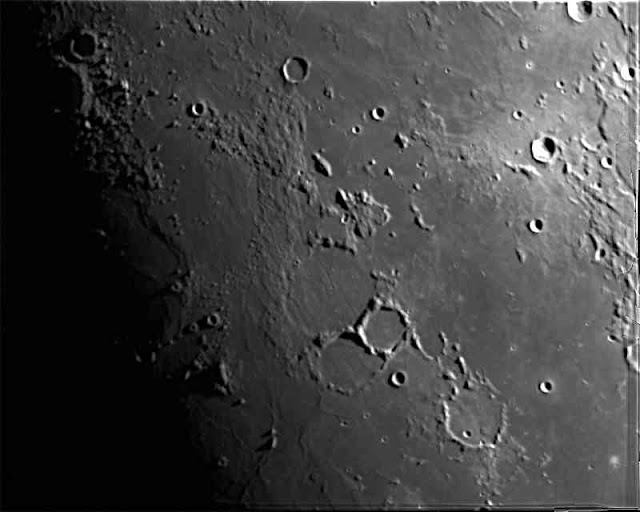One
day, Two Astronomy Sessions
Monday,
well actually Sunday, I decided that mornings were substantially
better for trying to see anything in the “night” sky. Maybe that
would be better said, when the sun in below the horizon enough to
make it seem like it's night. That would be because Monday morning
started about 5 AM with the idea from Sunday to get up early,
hopefully before the clouds returned, and see what could be seen in
the sky. With the haze, VERY high humidity, and the possibility that
my eyes weren't completely open, the only real target was the moon.
Fortunately, that's what I had planned for on Sunday.
The
list of lunar objects is being drawn from the Astronomical League's
“Lunar List”. These images are from the list and were close to
the terminator (division between day and night), which is where I
like to photograph them. As with my carvings, a low angle of light
makes the relief stand out better.
 |
| Manilius and Rima Hyginus |
This
image shows off two of the targets, as will the next image, in one
photo. The prominent crater just above the center is target #1,
Manilius. The thumbnail sketch is that it's about 24 miles in
diameter, has a central mountain, and is about 9400 feet deep. I find
it's interesting that to the right of the crater, the terrain is
rough, while to the left, the terrain is very smooth. I wonder why?
Target #2 is at the lower left. It's a valley with a small crater
more or less in the center of the valley. It looks somewhat like a
bird in flight, with a small body and very long, thin wings. This is
Rima Hyginus. “Rima” translates to “groove” and it's believed
that this groove was once a lava tube that has collapsed. Its about
133 miles long and about 2 miles wide. The crater in the center is
Hyginus, and is a sight of Transient Lunar Phenomena (TLP), according
to Virtual Moon Atlas. The Phenomena? “smokes according to Sacco.”
What?? Well, Hyginus is a crater believed to be formed by a volcano,
rather than an impact crater. The moon, as I understand it, is
supposed to be volcanically Inactive, but, who knows? Five minutes of
research on the net does show some references to TLP activity in this
area of the moon! Who knew? I might image this one more often.
This
is another two in one image, this time two crater groups in the
southern part of the moon. The craters, marked as you can see are
Maurolycus and Gemma Frisius. Maurolycus is about 69 miles in
diameter and that apparently is big enough to have small craters on
the floor of this crater. For me, one of the interesting things to
see is that the shadow covering the floor of the crater is larger
than some of the surrounding craters. That most likely indicates how
deep the crater is relative to some of the surrounding craters. Gemma
Frisius is about 53 miles in diameter. Other than that, I don't know
much more about these two craters.
 |
| Mars F10 |
 |
| Mars F 30 |
 |
| Yep, that's Saturn |
The
other two targets for the day are rather obvious when you look at
them. They are, of course, Mars and Saturn. I might keep track of
Mars as often as I can, because it looks like there might be a storm
a-brewing. I want to see if the dark area that looks like a funny
looking “X” changes over time. Of course, that means the clouds
have to part, so good luck with that, I guess. The reason for two
images of Mars that look slightly different, is because I wanted to
experiment with changing focal length of the scope and observing it's
impact on the resulting image. One result was expected, one not. The
expected result: the F30 images looks a little darker. Why? (Thank
you for asking.) The same amount of light is spread out over a larger
field of view (FOV). Same light, larger surface area = dimmer image.
The unexpected result: just how similar in detail the images are. I
was expecting a little more detail in the F30 image, but it's not
there. That very likely is because the seeing (steadiness mostly, in
this case) was poor. Think of taking a picture of a runner. If the
shutter is open too long, you get a blurred picture. Basically,
that's what is happening here.
Until next time.







